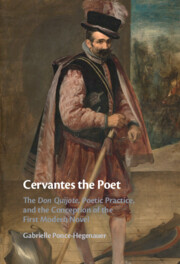 Cervantes the Poet
Cervantes the Poet Book contents
- Cervantes the Poet
- Cervantes the Poet
- Copyright page
- Dedication
- Contents
- Figures
- Acknowledgments
- Note on Abbreviations, Translations, and Terms
- Introduction The Unknown History of the Conception of the Don Quijote
- Chapter 1 Mimesis in the Court of Gentlewomen: The Pastoral Fabric of Everyday Life
- Chapter 2 Exalted Apostrophes: Cervantes in the Court of Isabel de Valois
- Chapter 3 Figura of the Poet: Pastoral Petrarchism as the Practice of Ingenious Gentlemen
- Chapter 4 The Form of Beauty: Lyric Lovers in the Mediterranean World
- Chapter 5 The Poet as Literary Character: Eclogues and Encomia in Madrid
- Chapter 6 The Literary Character as Poet: Lyric Subjectivity, Chronotopic Dynamism, and Plot in the Galatea
- Coda Alonso Quijano’s Lyric Subjectivity:
- Index
Chapter 6 - The Literary Character as Poet: Lyric Subjectivity, Chronotopic Dynamism, and Plot in the Galatea
Published online by Cambridge University Press: 11 May 2023
- Cervantes the Poet
- Cervantes the Poet
- Copyright page
- Dedication
- Contents
- Figures
- Acknowledgments
- Note on Abbreviations, Translations, and Terms
- Introduction The Unknown History of the Conception of the Don Quijote
- Chapter 1 Mimesis in the Court of Gentlewomen: The Pastoral Fabric of Everyday Life
- Chapter 2 Exalted Apostrophes: Cervantes in the Court of Isabel de Valois
- Chapter 3 Figura of the Poet: Pastoral Petrarchism as the Practice of Ingenious Gentlemen
- Chapter 4 The Form of Beauty: Lyric Lovers in the Mediterranean World
- Chapter 5 The Poet as Literary Character: Eclogues and Encomia in Madrid
- Chapter 6 The Literary Character as Poet: Lyric Subjectivity, Chronotopic Dynamism, and Plot in the Galatea
- Coda Alonso Quijano’s Lyric Subjectivity:
- Index
Summary
Chapter 6 examines the force of lyric subjectivity as narrative emplotment in the Galatea. At the confluence of verse and prose, allegory and history, mimesis and poiesis, this chapter treats the Galatea and contemporary works, beginning with the 1582 transition from verse to prose in Pedro de Padilla’s Églogas pastoriles (Seville). While the Galatea has often been dismissed in scholarship as a partially formed and immature work, or reinterpreted through standard approaches to the DQ, this chapter studies the chronotopic dynamism of Cervantes’ first prose fiction through the narrative emplotment of Lauso’s lyric interior. It is attuned to the sophisticated narrative architecture of an unprecedented capacity to juggle multiple lyric temporalities within a single narrative landscape. The Galatea lent novelistic immediacy to the timeless retreat of the pastoral through the use of lyric subjectivity. As a meditation on the nature of love and lyric subjectivity inherent in Pastoral Petrarchism, in the Galatea the figura of the poet as literary character was fully developed in Lauso. As a novel in key, the Galatea not only pertained to the fábulas of Cervantes’ literary milieu, it also wove a tapestry of narrativized lyric intersubjectivity necessary to the conception of the first modern novel.
Keywords
- Type
- Chapter
- Information
- Cervantes the PoetThe <i>Don Quijote</i>, Poetic Practice, and the Conception of the First Modern Novel, pp. 198 - 241Publisher: Cambridge University PressPrint publication year: 2023
